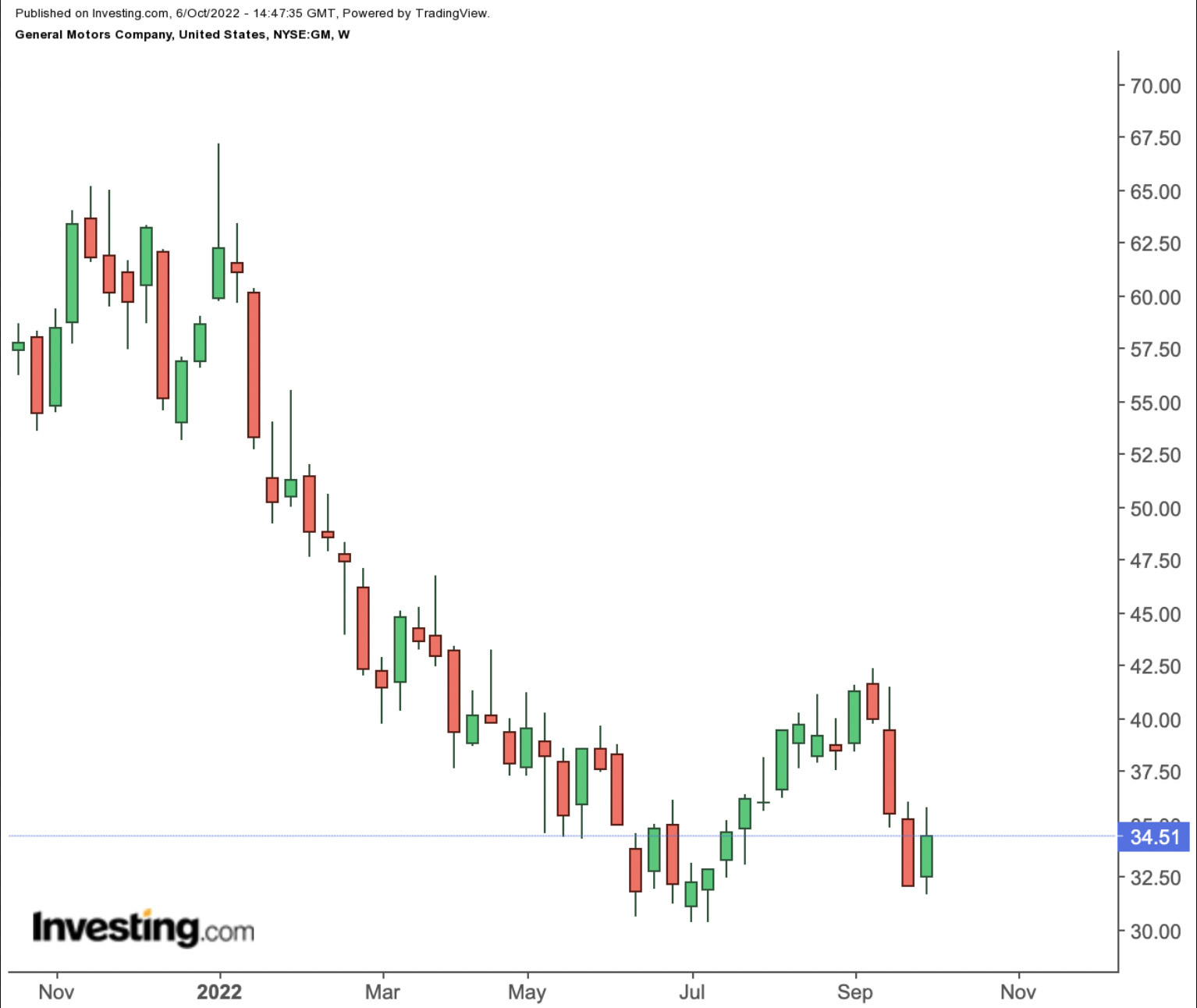- GM’s third-quarter sales report looks impressive, with the company taking market share in several categories
- The EV strategy shows promise, though competition still ahead
- GM’s focus on high-dollar vehicles means the economy needs to cooperate for stock to bounce off the lows
It appears exceptionally easy to make a bull case for General Motors (NYSE:GM) at the moment. Based on Wall Street estimates, GM stock trades at about 5x this year’s earnings. Yet, performance continues to impress, as evidenced by the company’s third-quarter sales report. Longer term, the shift to electric and autonomous vehicles seems to imply further upside.
But the story here isn’t quite that simple. GM’s big 2021 and 2022 numbers explain, at least in part, why GM stock should be priced at such a low multiple. Long-term EV and AV growth isn’t necessarily additive. And the history of both the company and the industry shows the near-term risks to earnings and the stock.
At these levels, those risks to some extent do appear priced in. From a long-term perspective, GM stock looks attractive. But the company will need some outside help for the case to play out in the near term.

Investing.com
The 5x Earnings Problem
GM’s third-quarter sales report highlights both the reason for owning GM stock — and the reason for staying away.
The auto manufacturer unquestionably had an impressive quarter. Total unit sales rose 24% year-over-year. As the company noted, it hit the “trifecta,” with leading market share in full-size sport-utility vehicles, full-size pickups and large luxury SUVs.
Even the company’s EV strategy is working, with “unprecedented customer demand” for the Bolt line. GM plans to increase production in 2023 to more than 70,000 vehicles.
Looking backwards, that’s clearly good news. The risks are more apparent looking forward.
GM’s sales strength clearly correlated to the most expensive — and most profitable — vehicles. Those vehicles are easy to sell right now, relatively speaking. Unemployment remains low. Inflation is a concern, certainly, but it’s less of a worry for the higher-income customers driving full-sized pickup and SUV sales .
So far, the U.S. economy has held up reasonably well. In that context, it’s little surprise that GM sales have done the same. The clear worry is that amid Federal Reserve interest hikes and macroeconomic pressures overseas, both the economy and sales will turn south.
This, of course, is always the risk to a cyclical business like auto manufacturing. But given GM’s specific strength in the highest-dollar categories, and the near-cessation of lower-priced sedan and coupe production by U.S. automakers, the risks are even higher than usual. Clearly, the market believes the cycle is going to send GM profits lower, which is why it’s assigning such a low multiple to the profits the company is earning now.
The EV/AV Question
That’s the short-term risk. The longer-term fear about both GM and rival Ford (NYSE:F) is that the shift to electric and autonomous vehicles too starts to erode profits.
As far as electric vehicles go, it’s important to remember a key fact: EVs don’t expand the market. The total number of new vehicles required by consumers doesn’t really change depending on whether they’re electric or have an internal combustion engine. Very roughly speaking, every EV sale for the industry means one fewer combustion-engine model sale.
For GM, the story admittedly is a bit different, since the Bolt and the Bolt EUV both target categories in which the company’s combustion-engine models have low market share. Still, the guided production for 2023 is less than 4% of total vehicle production this year. Meanwhile, EV leader Tesla (NASDAQ:TSLA), along with other new entrants like Rivian Automotive (NASDAQ:RIVN) and Lucid Inc (NASDAQ:LCID), are targeting GM’s more profitable markets.
In terms of autonomous vehicles, the news is even worse. In theory, autonomous vehicles would significantly lower overall demand. The need for individual automobile ownership would plunge in a world where an app could simply call up an AV whenever needed. (This, of course, is why Uber (NYSE:UBER) spent so many billions on its autonomous efforts.) If GM’s Cruise division isn’t successful, autonomous vehicles could significantly eat away at the company’s revenue and profits.
Eye Of The Beholder
At the least, investors should understand the bear case for GM stock. The 5x earnings multiple on its own is not enough to make GM an easy buy. There are risks here, both short-term and long-term.
That said, there are potential rewards as well. The company is executing well. It is taking market share. Valuation is reasonable even if profits do turn south amid a more difficult macro environment.
Indeed, the Wall Street response to the Q3 sales report shows both sides of the proverbial coin. Morgan Stanley cut GM’s price target to $30, arguing GM was going to warn on profits at some point. Citigroup kept its price target at $78, seeing the potential for higher inventory and, thus, higher sales.
If the economy holds up, that inventory build should drive profit growth and push GM stock price. If it doesn’t, the news can get ugly in a hurry. After all, it was only 13 years ago that, amid the financial crisis, General Motors filed for bankruptcy. A repeat of that event is exceptionally unlikely, but lower profits and a lower stock price are not.
Disclaimer: As of this writing, Vince Martin is short TSLA. He has no positions in any other securities mentioned.
